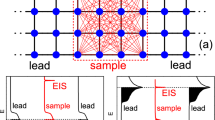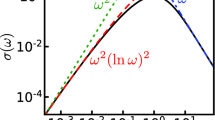Abstract
We study the electronic transport properties of the Anderson model on a strip, modeling a quasi one-dimensional disordered quantum wire. In the literature, the standard description of such wires is via random matrix theory. Our objective is to firmly relate this theory to a microscopic model. We correct and extend previous work (Bachmann and De Roeck in J. Stat. Phys. 139:541–564, 2010) on the same topic. In particular, we obtain through a physically motivated scaling limit an ensemble of random matrices that is close to, but not identical to the standard transfer matrix ensembles (sometimes called TOE, TUE), corresponding to the Dyson symmetry classes β=1,2. In the β=2 class, the resulting conductance is the same as the one from the ideal ensemble, i.e. from TUE. In the β=1 class, we find a deviation from TOE. It remains to be seen whether or not this deviation vanishes in a thick-wire limit, which is the appropriate regime for metals. For the ideal ensembles, we also prove Ohm’s law for all symmetry classes, making mathematically precise a moment expansion by Mello and Stone in Phys. Rev. B 44:3559–3576, 1991. This proof bypasses the explicit but intricate solution methods that underlie most previous results.
Similar content being viewed by others
Notes
The physically most natural way to discuss β=4 as well would be to consider electrons with spin, which we chose not to do for reasons of simplicity.
References
Bachmann, S., De Roeck, W.: From the Anderson model on a strip to the DMPK equation and random matrix theory. J. Stat. Phys. 139, 541–564 (2010)
Beenakker, C.W.J.: Random-matrix theory of quantum transport. Rev. Mod. Phys. 69, 731–808 (1997)
Beenakker, C.W.J., Rejaei, B.: Nonlogarithmic repulsion of transmission eigenvalues in a disordered wire. Phys. Rev. Lett. 71, 3689–3692 (1993)
Brouwer, P.W., Mudry, C., Furusaki, A.: Nonuniversality in quantum wires with off-diagonal disorder: a geometric point of view. Nucl. Phys. B 565(3), 653–663 (2000)
Büttiker, M., Imry, Y., Landauer, R., Pinhas, S.: Generalized many-channel conductance formula with application to small rings. Phys. Rev. B 31, 6207–6215 (1985)
Butz, M.: Existence of a unique strong solution to the DMPK equation. arXiv:1205.3396 (2012)
Caselle, M.: Distribution of transmission eigenvalues in disordered wires. Phys. Rev. Lett. 74, 2776–2779 (1995)
Caselle, M.: A new classification scheme for random matrix theories. http://arxiv.org/pdf/cond-mat/9610017 (1996)
Dorokhov, O.N.: Transmission coefficient and the localization length of an electron in N bound disordered chains. JETP Lett. 36(7), 318–321 (1982)
Dorokhov, O.N.: Solvable model of multichannel localization. Phys. Rev. B 37, 10526–10541 (1988)
Erdös, L., Yau, H.T.: Universality of local spectral statistics of random matrices. Bull. Amer. Math. Soc. 49(3), 377–414 (2012)
Ethier, S.N., Kurtz, T.G.: Invariance Principles and Diffusion Approximations, pp. 337–364. Wiley, New York (2008)
Hüffmann, A.: Disordered wires from a geometric viewpoint. J. Phys. A 23(24), 5733 (1990)
Jacod, J., Shiryaev, A.: Limit Theorems for Stochastic Processes, 2nd edn. Springer, Berlin (2003)
Lee, P.A., Stone, A.D.: Universal conductance fluctuations in metals. Phys. Rev. Lett. 55, 1622–1625 (1985)
Macedo, A.M.S., Chalker, J.: Exact results for the level density and two-point correlation function of the transmission-matrix eigenvalues in quasi-one-dimensional conductors. Phys. Rev. B 49(7), 4695–4702 (1994)
Mello, P.A., Pereyra, P., Kumar, N.: Macroscopic approach to multichannel disordered conductors. Ann. Phys. 181(2), 290–317 (1988)
Mello, P.A., Stone, A.D.: Maximum-entropy model for quantum-mechanical interference effects in metallic conductors. Phys. Rev. B 44, 3559–3576 (1991)
Römer, R., Schulz-Baldes, H.: The random phase property and the Lyapunov spectrum for disordered multi-channel systems. J. Stat. Phys. 140, 122–153 (2010)
Sadel, C., Schulz-Baldes, H.: Random Lie group actions on compact manifolds: A perturbative analysis. Ann. Probab. 38(6), 2224–2257 (2010)
Valko, B., Virag, B.: Random Schrödinger operators on long boxes, noise explosion and the GOE. http://arxiv.org/abs/0912.0097v3 (2009)
Wegner, F.J.: Disordered system with n orbitals per site: n=∞ limit. Phys. Rev. B 19, 783–792 (1979)
Zirnbauer, M.: Super Fourier analysis and localization in disordered wires. Phys. Rev. Lett. 69, 1584–1587 (1992)
Acknowledgements
Maximilian Butz benefited a lot from discussions with members of Antti Kupiainen’s group at Helsinki University, and is grateful for financial support by the Academy of Finland during his stay there. Sven Bachmann gratefully acknowledges the support of the National Science Foundation under Grant #DMS-0757581.
Author information
Authors and Affiliations
Corresponding author
Additional information
On leave from University of Heidelberg (W. De Roeck).
Rights and permissions
About this article
Cite this article
Bachmann, S., Butz, M. & De Roeck, W. Disordered Quantum Wires: Microscopic Origins of the DMPK Theory and Ohm’s Law. J Stat Phys 148, 164–189 (2012). https://doi.org/10.1007/s10955-012-0517-7
Received:
Accepted:
Published:
Issue Date:
DOI: https://doi.org/10.1007/s10955-012-0517-7




